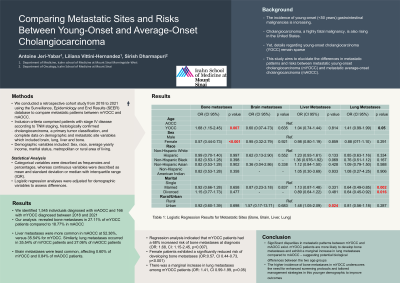Monday Poster Session
Category: Biliary/Pancreas
P1749 - Comparison of Metastatic Patterns and Risks Between Young Onset and Average Onset Cholangiocarcinoma
Monday, October 28, 2024
10:30 AM - 4:00 PM ET
Location: Exhibit Hall E

Has Audio

Antoine Jeri-Yabar, MD
Icahn School of Medicine at Mount Sinai Morningside/West
Manhattan, NY
Presenting Author(s)
Antoine Jeri-Yabar, MD1, Liliana Vittini-Hernandez, MD2, Bharati Dev, DO3, Sebastian Prado-Nuñez, MD4
1Icahn School of Medicine at Mount Sinai Morningside/West, Manhattan, NY; 2Mount Sinai Beth Israel, Icahn School of Medicine at Mount Sinai, Manhattan, NY; 3Icahn School of Medicine at Mount Sinai Morningside/West, New York, NY; 4Universidad Peruana Cayetano Heredia, Lima, Lima, Peru
Introduction: The incidence of young-onset (< 50 years) gastrointestinal malignancies is increasing. Cholangiocarcinoma, a highly fatal malignancy, is also rising in the United States. Yet, details regarding young-onset cholangiocarcinoma (YOCC) remain sparse. This study aims to elucidate the differences in metastatic patterns and risks between metastatic young-onset cholangiocarcinoma (mYOCC) and metastatic average-onset cholangiocarcinoma (mAOCC).
Methods: We conducted a retrospective cohort study from 2018 to 2021 using the Surveillance, Epidemiology, and End Results (SEER) database to compare metastases patterns between mYOCC (age < 50) and mAOCC (age ≥ 50). Inclusion criteria comprised patients with stage IV disease according to TNM staging, histologically confirmed cholangiocarcinoma, a primary tumor classification, and complete data on demographic and metastatic site variables which included brain, lung, liver and bone. Logistic regression analyses were adjusted for demographic variables to assess differences.
Results: We identified 1,545 individuals diagnosed with mAOCC and 166 with mYOCC. Analysis revealed bone metastases in 27.11% of mYOCC patients compared to 18.77% in mAOCC. Liver metastases were more common in mAOCC at 52.36%, versus 35.54% for mYOCC. Similarly, lung metastases occurred in 35.54% of mYOCC patients and 27.06% of mAOCC patients. Brain metastases were least common, affecting 0.60% of mYOCC and 0.84% of mAOCC patients. Regression analysis indicated that mYOCC patients had a 68% increased risk of bone metastases at diagnosis (OR: 1.68, CI: 1.15-2.45, p=0.007). Female patients exhibited a significantly reduced risk of developing bone metastases (OR:0.57, CI 0.44-0.73, p< 0.001). Furthermore, there was a marginal increase in lung metastases among mYOCC patients (OR: 1.41, CI 0.99-1.99, p=0.05).
Discussion: Significant disparities in metastatic patterns between mYOCC and mAOCC exist. mYOCC patients are more likely to develop bone metastases and exhibit a marginal increase in lung metastases compared to mAOCC – suggesting potential biological differences between the two age groups. The higher incidence of bone metastases in mYOCC underscores the need for enhanced screening protocols and tailored management strategies in this younger demographic to improve outcomes.
Note: The table for this abstract can be viewed in the ePoster Gallery section of the ACG 2024 ePoster Site or in The American Journal of Gastroenterology's abstract supplement issue, both of which will be available starting October 27, 2024.
Disclosures:
Antoine Jeri-Yabar, MD1, Liliana Vittini-Hernandez, MD2, Bharati Dev, DO3, Sebastian Prado-Nuñez, MD4. P1749 - Comparison of Metastatic Patterns and Risks Between Young Onset and Average Onset Cholangiocarcinoma, ACG 2024 Annual Scientific Meeting Abstracts. Philadelphia, PA: American College of Gastroenterology.
1Icahn School of Medicine at Mount Sinai Morningside/West, Manhattan, NY; 2Mount Sinai Beth Israel, Icahn School of Medicine at Mount Sinai, Manhattan, NY; 3Icahn School of Medicine at Mount Sinai Morningside/West, New York, NY; 4Universidad Peruana Cayetano Heredia, Lima, Lima, Peru
Introduction: The incidence of young-onset (< 50 years) gastrointestinal malignancies is increasing. Cholangiocarcinoma, a highly fatal malignancy, is also rising in the United States. Yet, details regarding young-onset cholangiocarcinoma (YOCC) remain sparse. This study aims to elucidate the differences in metastatic patterns and risks between metastatic young-onset cholangiocarcinoma (mYOCC) and metastatic average-onset cholangiocarcinoma (mAOCC).
Methods: We conducted a retrospective cohort study from 2018 to 2021 using the Surveillance, Epidemiology, and End Results (SEER) database to compare metastases patterns between mYOCC (age < 50) and mAOCC (age ≥ 50). Inclusion criteria comprised patients with stage IV disease according to TNM staging, histologically confirmed cholangiocarcinoma, a primary tumor classification, and complete data on demographic and metastatic site variables which included brain, lung, liver and bone. Logistic regression analyses were adjusted for demographic variables to assess differences.
Results: We identified 1,545 individuals diagnosed with mAOCC and 166 with mYOCC. Analysis revealed bone metastases in 27.11% of mYOCC patients compared to 18.77% in mAOCC. Liver metastases were more common in mAOCC at 52.36%, versus 35.54% for mYOCC. Similarly, lung metastases occurred in 35.54% of mYOCC patients and 27.06% of mAOCC patients. Brain metastases were least common, affecting 0.60% of mYOCC and 0.84% of mAOCC patients. Regression analysis indicated that mYOCC patients had a 68% increased risk of bone metastases at diagnosis (OR: 1.68, CI: 1.15-2.45, p=0.007). Female patients exhibited a significantly reduced risk of developing bone metastases (OR:0.57, CI 0.44-0.73, p< 0.001). Furthermore, there was a marginal increase in lung metastases among mYOCC patients (OR: 1.41, CI 0.99-1.99, p=0.05).
Discussion: Significant disparities in metastatic patterns between mYOCC and mAOCC exist. mYOCC patients are more likely to develop bone metastases and exhibit a marginal increase in lung metastases compared to mAOCC – suggesting potential biological differences between the two age groups. The higher incidence of bone metastases in mYOCC underscores the need for enhanced screening protocols and tailored management strategies in this younger demographic to improve outcomes.
Note: The table for this abstract can be viewed in the ePoster Gallery section of the ACG 2024 ePoster Site or in The American Journal of Gastroenterology's abstract supplement issue, both of which will be available starting October 27, 2024.
Disclosures:
Antoine Jeri-Yabar indicated no relevant financial relationships.
Liliana Vittini-Hernandez indicated no relevant financial relationships.
Bharati Dev indicated no relevant financial relationships.
Sebastian Prado-Nuñez indicated no relevant financial relationships.
Antoine Jeri-Yabar, MD1, Liliana Vittini-Hernandez, MD2, Bharati Dev, DO3, Sebastian Prado-Nuñez, MD4. P1749 - Comparison of Metastatic Patterns and Risks Between Young Onset and Average Onset Cholangiocarcinoma, ACG 2024 Annual Scientific Meeting Abstracts. Philadelphia, PA: American College of Gastroenterology.
